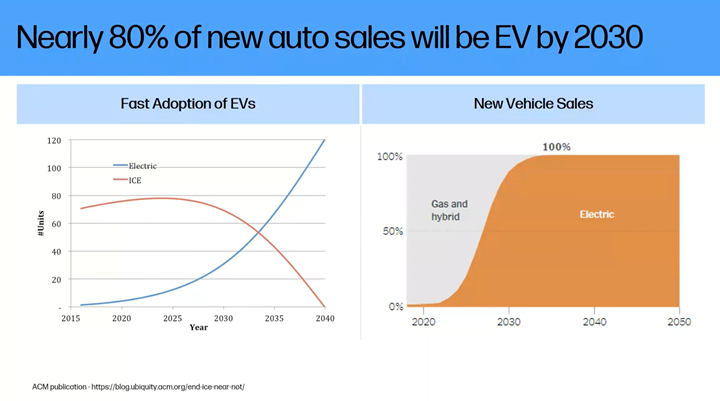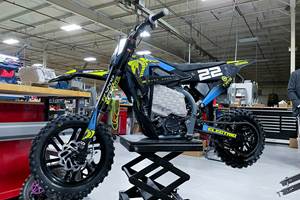How Aggressive EV Timelines Point to AM
Electric vehicle sales are expected to grow significantly in the next decade. Additive manufacturing can help automakers fill their production needs.
Electric vehicles (EV) are here to stay. Looking at the numbers, they’ll do more than just stay. Consider these statistics and projections:
- Q1 2022 saw electric and hybrid models accounting for 40% of new car sales in France, compared to 38.3% for gasoline models. (Plateforme de la Filière Automobile (2022), Le marché automobile français mars 2022)
- In the next seven years, approximately 350 new EV models are expected to hit the automotive market worldwide. (IEA (2021), Global EV Outlook 2021)
- By 2030, almost 80% of all new car sales will be EV. (Association for Computing Machinery ACM (2017), The End of ICE is Near – or Not?)
- These projections may see some influx due to the 2022 Inflation Reduction Act, which impacts the tax credit for new electric vehicles with final assembly in North America and pre-owned consumer and commercial clean vehicles. (U.S. Department of the Treasury (2022), Treasury Releases Initial Information on Electric Vehicle Tax Credit Under Newly Enacted Inflation Reduction Act)
According to the Association for Computing Machinery, EV sales will make up almost 80% of new auto sales by 2030. Note that this percentage represents fully electric vehicles. Both gas and hybrid vehicles will see a decline. Photo Credit: ACM
What role does additive manufacturing play in this progression? Two different sets of presenters recently explored this question in presentations given live (and still viewable on demand) on the Additive Manufacturing website. Alex Stern, manufacturing platform strategy lead with Autodesk, and Matteo Barale, chief product officer with PixMoving, gave a talk titled, “3D Printing for Electric Vehicles: Discovering Design Freedom and Mass Customization from the Electrification Revolution,” while HP solutions architect Aaron DeLong and 3D application engineer Wes Kramer, along with Wagon Wills, chief engineer of Gonzalez, gave a talk titled, “3D Printing for Electric Vehicles: Addressing Accelerated EV Timelines with Additive Manufacturing.” This article captures some of the takeaways of their presentations.
AM’s Impact on EV Production
For any automaker, especially those with concepts, tooling and production lines established for vehicles with internal combustion engines, these projections represent an aggressive timeline that demands accelerated product development cycles to meet it. This is just in time to face the added crunch of global supply chain issues already impacting present day automotive inventory.
This is where additive manufacturing can make an impact. With additive manufacturing’s inherent digital scope, automakers can work through concepts and renderings, but most important, they can work through tangible iterations.
“We can do them with engineering materials, we can really align to those material specifications,” says DeLong. “We can use tools like FEA and CFD to predict on the additive side what we’re going to get in production, from the injection molding. If we understand our additive material sets, we can predict whether the failure mode of the additive piece aligns with the failure mode of the injection molded piece and then predict what the injection molded piece is going to do.”’
DeLong further highlights AM’s impact through several air flow examples, including redesigning a flow splitter to optimize the cooling of a scalable EV battery platform. The solution he describes cut design time by 50% and reduced pressure drop by 47% through topology optimization and an additively manufactured part.
Both optimized parts and reduced production time will have an impact on an EV manufacturer’s bottom line, which is necessary and pragmatic, but EV’s potential — and AM’s role — also goes beyond practical concerns. Stern and Barale’s presentation makes it clear that if the future of automotive is electric, then the future of electric is boundless passenger experience.
Rethinking the Passenger Experience
EVs are typically built upon a flat platform called a skateboard chassis that houses the batteries and motor. This foundation is essentially a blank slate for designers.
Stern explains that the electric drive train is heading toward standardization, but that does not mean all electric vehicles will look the same or even meet the same needs.
“The beauty of this is, of course, cost, high quality, everything that comes with standardization and mass production, but also this is relatively modular,” says Stern. “You can slightly alter this platform architecture and build different types of vehicles on top.”
Imagine then, a people carrier and a sedan utilizing essentially the same platform. This is easier to do with EV than conventional automotive, according to Stern, as electric vehicles face fewer packaging issues and the overall design is less engineering driven.
PixMoving’s Ultra Skateboard chassis is an example of how electric vehicles open the door for design freedom and optimized passenger experience. Photo Credit: PixMoving
EV and Autonomous Driving
Although the precipice for widespread autonomous driving is not as close as that for widespread electric vehicles, forward thinking automakers will see the potential crossover in design freedom when they consider all the things a driver can do in a car when they don’t have to drive. Stern compared the future driver’s seat to a business class seat on a plane, and the vehicle to a smartphone on wheels. Conventional design does not address a driver who might be streaming videos, socializing or even sleeping in the vehicle.
With so much interior customization potential, Stern predicts high volume manufacturing may take a backseat to small batch production when it comes to autonomous driving EVs.
Small batch production will require a different manufacturing environment, one PixMoving has already established. Barale describes the environment as a flexible factory comprised of automation and 3D printing technology that has a smaller real estate footprint and less pollution than a conventional automotive assembly line. One perk of this factory style is its potential for distributed manufacturing, an area in which additive has found success. Stern explains, too, that these smaller, cleaner factories are easier to integrate into an urban setting, allowing vehicles to be made closer to where customers live, curtailing possible supply chain complications.
For more on additive manufacturing and electric vehicles, including links to the presentations referenced above, visit gbm.media/am4ev.
Related Content
Additive Manufacturing Is Subtractive, Too: How CNC Machining Integrates With AM (Includes Video)
For Keselowski Advanced Manufacturing, succeeding with laser powder bed fusion as a production process means developing a machine shop that is responsive to, and moves at the pacing of, metal 3D printing.
Read MoreNew Electric Dirt Bike Is Designed for Molding, but Produced Through 3D Printing (Includes Video)
Cobra Moto’s new all-electric youth motocross bike could not wait for mold tooling. Parts have been designed so they can be molded eventually, but to get the bike to market, the production method now is additive manufacturing.
Read MoreUnderstanding HP's Metal Jet: Beyond Part Geometry, Now It's About Modularity, Automation and Scale
Since introducing its metal binder jetting platform at IMTS in 2018, HP has made significant strides to commercialize the technology as a serial production solution. We got an early preview of the just-announced Metal Jet S100.
Read More3D Printing with Plastic Pellets – What You Need to Know
A few 3D printers today are capable of working directly with resin pellets for feedstock. That brings extreme flexibility in material options, but also requires greater knowledge of how to best process any given resin. Here’s how FGF machine maker JuggerBot 3D addresses both the printing technology and the process know-how.
Read MoreRead Next
3D Printing Brings Sustainability, Accessibility to Glass Manufacturing
Australian startup Maple Glass Printing has developed a process for extruding glass into artwork, lab implements and architectural elements. Along the way, the company has also found more efficient ways of recycling this material.
Read More4 Ways the Education and Training Challenge Is Different for Additive Manufacturing
The advance of additive manufacturing means we need more professionals educated in AM technology.
Read MoreAt General Atomics, Do Unmanned Aerial Systems Reveal the Future of Aircraft Manufacturing?
The maker of the Predator and SkyGuardian remote aircraft can implement additive manufacturing more rapidly and widely than the makers of other types of planes. The role of 3D printing in current and future UAS components hints at how far AM can go to save cost and time in aircraft production and design.
Read More




















